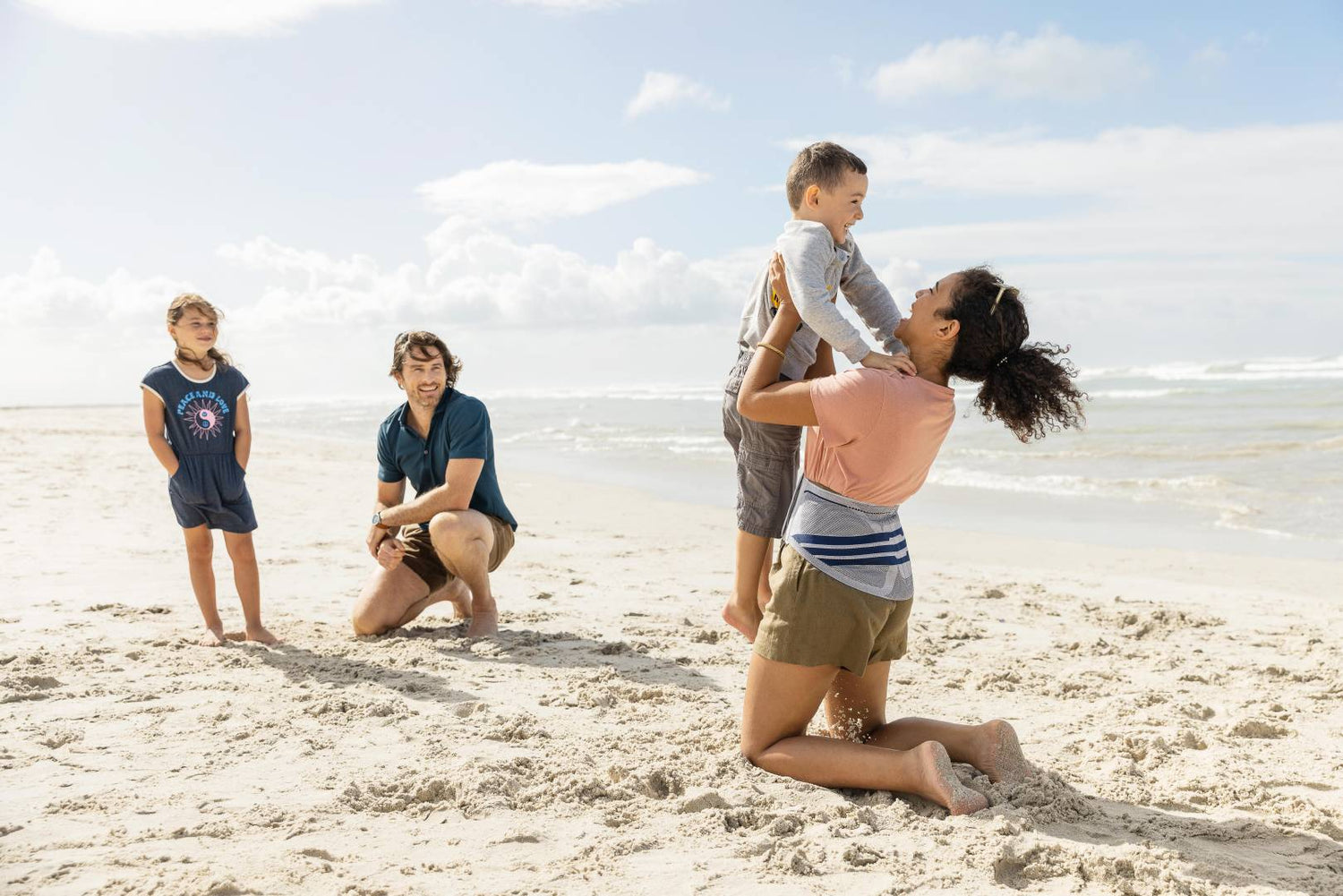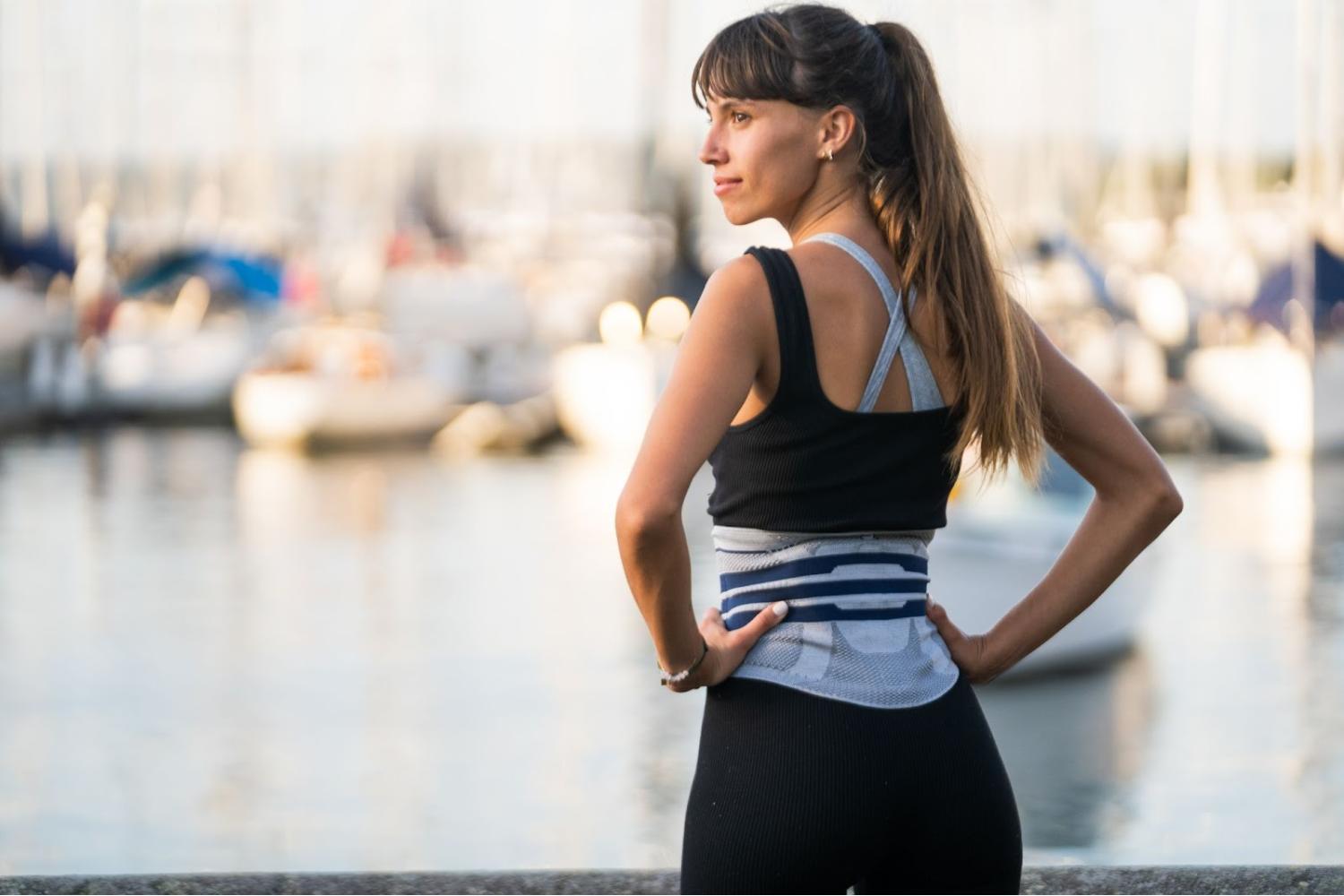Looking for a way to manage your lower back pain? Want extra protection for your back in sports or after an injury? Want to stop slouching so much? A lower back brace could be just the thing you need. From improving muscle activation to boosting blood flow, here are the benefits of a back brace.
Corrects posture

LumboTrain
A lot of us are, unfortunately, accustomed to slouching. And while the position may be much easier to achieve and more comfortable to maintain than sitting up straight, it’s no good for your back. So why is it so hard to stop? If you’ve been slouching your whole life, that’s simply what your core and lumbar muscles get used to. To quit the habit, you’ll need to retrain these muscles.
Here’s where a back brace comes in. Our LumboTrain incorporates medical-grade compression knit. When you wear the brace, the knit communicates with the muscles, helping them send and receive signals to and from the brain. Essentially, this improves how you activate your back and abdominal muscle groups and remind them to keep your posture, helping you retrain your slouching muscles.
If you have more advanced postural issues, however, we’d recommend the LordoLoc. This back brace covers more of the spine and incorporates aluminium stays to support your back muscles better.
Relieves pain
Back braces are also an effective way to relieve lower back pain. A CMRO study, for instance, found that the LumboTrain relieved participants’ non-specific back pain (i.e., general back pain not associated with acute injury or degenerative disorder). It does so through its muscle-activating compression knit and a sacral gel pad that massages painful areas as you move. However, how effectively a back brace relieves back pain depends on how suitable it is for your condition.
For example, the LumboTrain may relieve non-specific back and lumbar pain from milder injuries and conditions. But a simple compression brace may not be enough if your lumbar has a bulging disk. In this case, you may need something like the LumboLoc forte, which incorporates stays and a lumbar belt to stabilise the back and unload the lumbar vertebrae.

LumboLoc Forte
Helps in injury recovery
On that note, a good back brace can help you recover from certain back injuries. Because along with relieving pain, they also:
- Reduce swelling. Compression knit fabric reduces the formation of edemas, your body’s inflammatory agents.
- Boost blood flow to injured tissues. The more blood you have flowing to your torn tendon, sprained ligament, or pulled muscle, the more oxygen and nutrients that injured tissue gets. While your body kick-starts delivery immediately after injury, it can sometimes go overboard, leading to congesting blood and swelling that makes it hard for your veins to pull waste out and for your arteries to move oxygen and nutrient-rich blood in. Compression knit fabric gently squeezes blood out of congested veins, moving the process along.
- Support your back. Compression braces like the LumboTrain do so by activating your muscles. Meanwhile, more rigid braces like the LordoLoc and LumboLoc forte combine compression fabric with external supports like straps and stays to restrict damaging movements.
- Keep you moving. Specialists agree that the absolute last thing your back needs is for you to relieve back pain by laying around. Additionally, research shows that exercise builds muscle strength and flexibility to reduce pain by taking some pressure off injured tissues. While you definitely shouldn't be playing high-contact sports or lifting heavy objects right after you strain, sprain, or herniate your lumbar, gentle exercise like yoga is great for maintaining muscle strength. And a supportive brace can make it much easier to do without pain.
Protects against injury

Sports Back Support
Back braces can also help protect your lumbar in sports. The Sports Back Support, for example, incorporates a similar structure to the LumboTrain. The breathable compression knit works directly with your muscles to improve how they support your spine. It will be especially handy for more physically demanding workouts like deadlifts and sports that put a lot of pressure on (and require a lot of movement from) your spine.
And no - not all back braces protect your spine by restricting movement. As the Sports Back Support has no rigid parts, it’s perfectly flexible. Hence, it won’t interfere with your ability to curve your spine this way and that while surfing or negatively affect your martial arts form.
Helps manage certain disorders
Last but not least, back braces can help you manage degenerative disorders, chronic instability, and sciatica. At the risk of sounding like a broken record:
- Compression knit activates muscles for improved support and boosts blood flow to relieve swelling and stiffness.
- Gel pads massage key areas as you move to ease pain.
- External supports (like stays and straps) help offload pressure away from certain areas in your hips or back.
As with injury recovery, the general rule of thumb is that softer braces are best for milder conditions and symptoms. In contrast, more rigid braces like the SacroLoc and LumboLoc are ideal for serious cases.
Beyond lower back braces
As we always say, braces can do a lot for muscle activation, pain relief, and joint support. But for the bests results, you should combine them with other strategies.
- Strengthen. Your lumbar spine relies on the support of your core and intrinsic back muscles. The stronger they are, the less strain you put on your vertebrae and spinal disks. So, add Dead Bugs, Planks, and Bird Dog into your workout routine to prevent injury or work on your posture. You can also do these exercises to help you recover from a back injury. Just make sure to check with your doctor if they’re safe for you to do.
- Stretch. Child’s Pose, Downward Facing Dog, and Cat Cow are great ways to stretch your back, glutes and hamstrings. Maintaining these muscle groups' flexibility minimises your risk of pulling a muscle and tearing a tendon. They’re also a great way to gently mobilise your lumbar after injury (but again, clear them with your doctor).
- Think ergonomically. The best back brace in the world won’t protect you from back pain if you need to hunch over to look at your laptop for several hours a day. Ideally, your screen should sit at eye level. Your elbows should be near your ribs to avoid pulling on thoracic muscles and joints. Lastly, get a chair with good back support (or even just a decent lumbar cushion).
To sum up
Lower back braces can be a great addition to your routine. They support and protect your spine, boost circulation, and relieve pain. So if you want to protect your lumbar after an injury, manage a spinal condition, or even just work on your posture, a lumbar brace (along with some strengthening, stretching, and ergonomics work) is the perfect solution.
If you require assistance selecting the right product for your needs or wearing the brace, call us on 098015660 or contact us via live chat.
Do you have private health? Most private health extras will cover Bauerfeind Products. Check to see if yours is included. Bauerfeind Private Health Insurance Inquiry.
















